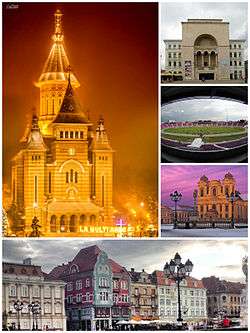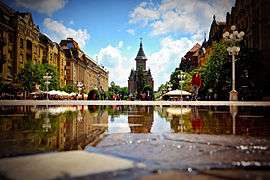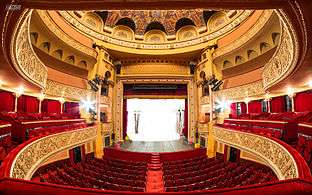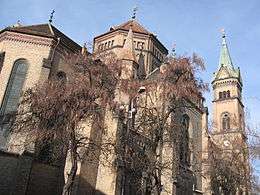Timișoara
| Timișoara | ||
|---|---|---|
| City | ||
|
Clockwise: Orthodox Cathedral, Romanian National Opera, Stadionul Dan Păltinișanu, St. George's Catholic Cathedral and the Union Square | ||
| ||
|
Nickname(s): Little Vienna, City of Flowers, Heart of Banat (Romanian: Mica Vienă, Orașul florilor, Inima Banatului)[1] | ||
 Timișoara Location of Timișoara within Romania | ||
| Coordinates: 45°45′35″N 21°13′48″E / 45.75972°N 21.23000°ECoordinates: 45°45′35″N 21°13′48″E / 45.75972°N 21.23000°E | ||
| Country |
| |
| County |
| |
| Status | County capital | |
| First official record | 1212 (as Temesiense) | |
| Government | ||
| • Mayor | Nicolae Robu (PNL) | |
| • Deputy Mayor | Dan Diaconu (PNL) | |
| • Deputy Mayor | Imre Farkas (UDMR/RMDSZ) | |
| Area | ||
| • City | 130.5 km2 (50.4 sq mi) | |
| • Metro | 1,570 km2 (610 sq mi) | |
| Elevation | 90 m (300 ft) | |
| Population (2011 census)[2] | ||
| • City |
319,279 | |
| • Rank | 3rd (98th in EU) | |
| • Density | 2,446.58/km2 (6,336.6/sq mi) | |
| • Urban |
347,613 | |
| • Metro |
418,415 | |
| Demonym(s) |
timișorean, timișoreancă (ro) temesvári (hu) | |
| Time zone | EET (UTC+2) | |
| • Summer (DST) | EEST (UTC+3) | |
| Postal code | 300001-300990 | |
| Tel. code | 0256 / 0356 | |
| Car Plates | TM | |
| Climate | Cfb | |
| Website |
www | |
| xTimișoara metropolitan area is a proposed project. | ||
Timișoara (Romanian pronunciation: [timiˈʃo̯ara]; German: Temeswar, also formerly Temeschburg or Temeschwar; Hungarian: Temesvár, Hungarian pronunciation: [ˈtɛmɛʃvaːr]; Yiddish: טעמשוואר; Serbian: Темишвар, Temišvar; Banat Bulgarian: Timišvár; Turkish: Temeşvar; Slovak: Temešvár) is the capital city of Timiș County, and the main social, economic and cultural centre in western Romania.
One of the largest Romanian cities (the third most populous city in the country, as of 2011 census), with a population of 319,279 inhabitants,[2] Timișoara is the informal capital city of the historical region of Banat. In September 2016, Timișoara was selected as the European Capital of Culture for 2021.[3]
History
Middle Ages
Timișoara was first mentioned as a place in either 1212 or 1266 as Castrum Temesiense.[4] The territory later to be known as Banat was conquered and annexed by the Kingdom of Hungary in 1030. Timișoara grew considerably during the reign of Charles I, who, upon his visit here in 1307, ordered the construction of a royal palace. Timișoara's importance also grew due to its strategic location, which facilitated control over the Banat plain. By the middle of the 14th century, Timișoara was at the forefront of Western Christendom's battle against the Muslim Ottoman Turks. French and Hungarian crusaders met at the city before engaging in the Battle of Nicopolis in 1396. Beginning in 1443, John Hunyadi used Timișoara as a military stronghold against the Turks, having built a powerful fortress. The city was repeatedly besieged by the Ottomans in 1462, 1476, 1491, and 1522.
16th–19th centuries
In 1552, a 16,000 Ottoman army led by Kara Ahmed Pasha conquered the city and transformed it into a capital city in the region (Temeşvar Eyalet). The local military commander, István Losonczy, along with other Christians were massacred on July 27, 1552 while escaping the city through the Azapilor Gate.[5]

Timișoara remained under Ottoman rule for nearly 160 years, controlled directly by the Sultan and enjoying a special status, similar to other cities in the region such as Budapest and Belgrade. During this period, Timișoara was home to a large Islamic community and produced famous historical figures such as Osman Aga of Temesvar, until Prince Eugene of Savoy conquered it in 1716. Subsequently, the city came under Habsburg rule, and it remained so until the early 20th century, except for the Ottoman occupation between 1788–1789 during the Ottoman-Habsburg war.[6] During this time, Timișoara evolved from a strategic fortress to an economic and industrial centre: numerous factories were built, electric illumination and public transport were introduced, and rail connections were established. The city was defortified starting in 1892 up until 1910,[7] and several major road arteries were built to connect the suburbs with the city centre, paving the way for further expansion of the city.
It was the first mainland European city and second in the world after New York to be lit by electric street lamps in 1884.[8][9] It was also the second European and the first city in what is now Romania with horse-drawn trams in 1869.[10] It is said that Gustave Eiffel, the creator of the Eiffel Tower in Paris, drew the projects of one of Timișoara's footbridges over the Bega, the "Metal Bridge", however, it was actually planned by Róbert Tóth, the head of the Bridge Department, at the Reșița rail factory.[11]
20th century

On October 31, 1918, local military and political elites establish the "Banat National Council", together with representatives of the region's main ethnic groups: Romanians, Germans, Serbs and Hungarians. On November 1 they proclaimed in Timișoara the short-lived Banat Republic. In the aftermath of World War I, the Banat region was divided between the Kingdom of Romania and the Kingdom of Serbs, Croats and Slovenes, and Timișoara came under Romanian administration after Serbian occupation between 1918–1919. The city was ceded from Hungary to Romania by the Treaty of Trianon on June 4, 1920. In 1920, King Ferdinand I awarded Timișoara the status of a University Centre, and the interwar years saw continuous economic and cultural development. A number of anti-fascist and anti-revisionist demonstrations also took place during this time.
During World War II, Timișoara suffered damage from both Allied and Axis bombing raids, especially during the second half of 1944. On August 23, 1944, Romania, which until then was a member of the Axis, declared war on Nazi Germany and joined the Allies. Surprised, the local Wehrmacht garrison surrendered without a fight, and German and Hungarian troops attempted to take the city by force throughout September, without success.
After the war, the People's Republic of Romania was proclaimed, and Timișoara underwent Sovietization and later, systematization. The city's population tripled between 1948 and 1992. In December 1989, Timișoara witnessed a series of mass street protests in what was to become the Romanian Revolution. On December 20, three days after bloodshed began there, Timișoara was declared the first city free of Communism in Romania.[12]
Geography
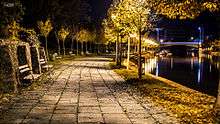
Timișoara lies at an altitude of 90 metres (300 feet) on the southeast edge of the Banat plain, part of the Pannonian Plain near the divergence of the Timiș and Bega rivers. The waters of the two rivers form a swampy and frequently flooded land. Timișoara developed on one of few places where the swamps could be crossed. These constituted a natural protection around the fortress for a very long time, however, they also favoured a wet and insalubrious climate, as well as the proliferation of the plague and cholera, which kept the number of inhabitants at a relatively low number and significantly prevented the development of the city. With time, however, the rivers of the area were drained, dammed and diverted. Due to these hydrographical projects undertaken in the 18th century, the city no longer lies on the Timiș River, but on the Bega canal. This improvement of the land was made irreversible by building the Bega canal (started in 1728) and by the complete draining of the surrounding marshes. However, the land across the city lies above a water table at a depth of only 0.5 to 5 metres (1.6–16.4 feet), a factor which does not allow the construction of tall buildings. The rich black soil and relatively high water table make this a fertile agricultural region.
This is a relatively active seismic area, and earthquakes up to 6 on the Richter scale have been recorded.
Climate
Climate in this area has mild differences between highs and lows, and there is adequate rainfall year-round. The Köppen Climate Classification subtype for this climate is "Cfb" (Marine West Coast Climate/Oceanic climate).[13]
The climate which defines Timișoara city is the temperate-oceanic climate (Köppen: Cfb) and can be regarded as humid continental (Dfb) when using an isotherm of 0 °C (32 °F). The city characterizes the Southern-Eastern part of The Pannonian Basin.
| Climate data for Timișoara, Romania (1961–1990) | |||||||||||||
|---|---|---|---|---|---|---|---|---|---|---|---|---|---|
| Month | Jan | Feb | Mar | Apr | May | Jun | Jul | Aug | Sep | Oct | Nov | Dec | Year |
| Record high °C (°F) | 17.4 (63.3) |
20.5 (68.9) |
28.2 (82.8) |
32.0 (89.6) |
34.5 (94.1) |
38.4 (101.1) |
41.1 (106) |
41.0 (105.8) |
39.7 (103.5) |
33.8 (92.8) |
27.1 (80.8) |
20.2 (68.4) |
41.1 (106) |
| Average high °C (°F) | 2.3 (36.1) |
5.6 (42.1) |
11.9 (53.4) |
17.6 (63.7) |
22.8 (73) |
25.7 (78.3) |
27.8 (82) |
27.6 (81.7) |
24.0 (75.2) |
18.1 (64.6) |
10.3 (50.5) |
4.2 (39.6) |
16.5 (61.7) |
| Daily mean °C (°F) | −1.6 (29.1) |
1.2 (34.2) |
5.8 (42.4) |
11.2 (52.2) |
16.3 (61.3) |
19.4 (66.9) |
21.1 (70) |
20.4 (68.7) |
16.5 (61.7) |
11.0 (51.8) |
5.6 (42.1) |
0.8 (33.4) |
10.6 (51.1) |
| Average low °C (°F) | −4.8 (23.4) |
−2.3 (27.9) |
1.2 (34.2) |
5.8 (42.4) |
10.1 (50.2) |
13.4 (56.1) |
14.6 (58.3) |
14.3 (57.7) |
11.2 (52.2) |
6.2 (43.2) |
2.1 (35.8) |
−1.7 (28.9) |
5.8 (42.4) |
| Record low °C (°F) | −35.3 (−31.5) |
−29.2 (−20.6) |
−20.0 (−4) |
−5.2 (22.6) |
−5.0 (23) |
2.2 (36) |
5.9 (42.6) |
5.0 (41) |
−1.9 (28.6) |
−6.8 (19.8) |
−15.4 (4.3) |
−24.8 (−12.6) |
−35.3 (−31.5) |
| Average precipitation mm (inches) | 40 (1.57) |
36 (1.42) |
37 (1.46) |
48 (1.89) |
65 (2.56) |
76 (2.99) |
64 (2.52) |
50 (1.97) |
40 (1.57) |
39 (1.54) |
48 (1.89) |
50 (1.97) |
593 (23.35) |
| Average snowfall cm (inches) | 9.8 (3.86) |
9.3 (3.66) |
4.4 (1.73) |
0.0 (0) |
0.0 (0) |
0.0 (0) |
0.0 (0) |
0.0 (0) |
0.0 (0) |
0.0 (0) |
3.7 (1.46) |
7.2 (2.83) |
34.4 (13.54) |
| Average precipitation days (≥ 1.0 mm) | 7 | 7 | 7 | 8 | 9 | 10 | 7 | 6 | 6 | 5 | 8 | 9 | 89 |
| Average relative humidity (%) | 90 | 86 | 79 | 73 | 73 | 74 | 73 | 75 | 76 | 81 | 85 | 89 | 79 |
| Mean monthly sunshine hours | 72.1 | 92.2 | 155.4 | 186.4 | 242.4 | 262.3 | 300.6 | 280.2 | 217.5 | 177.3 | 86.4 | 56.9 | 2,129.7 |
| Source #1: NOAA,[14] Deutscher Wetterdienst[15] | |||||||||||||
| Source #2: Romanian National Statistic Institute (extremes 1901–2000)[16] | |||||||||||||
- Highest recorded temperature: 41.1 °C (106 °F) – 24 July 2007
- Lowest recorded temperature: −35.3 °C (−32 °F) – 24 January 1963
- Snow stays on the ground 30 days a year on average
- Warmest month: July
- Coolest month: January
- Highest precipitation: June: 91.0 mm(3.589 in)
- Lowest precipitation: February: 44.5 mm(1.737 in)
Climatic general features consist of various and irregular weather conditions. The dominating temperate air masses during spring and summer are of oceanic origin and come with great precipitations. Frequently, even during winter period, the Atlantic humid air masses bring rainy and snowy weather, rarely cold weather.
From September until February, frequent continental polar air masses coming from the East invade the area. In spite of all that, the Banat climate is also influenced by the presence of cyclones and warm air masses which come from the Adriatic Sea and the Mediterranean. Their characteristic feature is that of complete snow thaw during the winter period and stifling heat during the summer period.
Freak measurable snowfalls have occurred as early as late October and as late as early April, but snow in those months is rare, and significant falls do not usually occur until late November. The median date for the first freeze is October 22, while that of the last freeze is April 15.
Demographics
| Historical population | ||
|---|---|---|
| Year | Pop. | ±% |
| 1787 | 9,479 | — |
| 1847 | 18,103 | +91.0% |
| 1869 | 32,725 | +80.8% |
| 1900 | 53,033 | +62.1% |
| 1910 | 72,555 | +36.8% |
| 1930 | 91,580 | +26.2% |
| 1948 | 111,987 | +22.3% |
| 1956 | 142,257 | +27.0% |
| 1966 | 174,243 | +22.5% |
| 1977 | 269,353 | +54.6% |
| 1992 | 334,115 | +24.0% |
| 2002 | 317,660 | −4.9% |
| 2011 | 319,279 | +0.5% |
| Source: Census data, Encyclopædia Britannica Eleventh Edition | ||
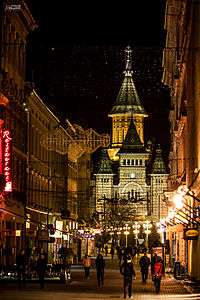
In 1910, when the city was part of the Kingdom of Hungary, it had 72,555 inhabitants. Of these, 31,644 (43.6%) were Germans, 28,552 (39.3%) Hungarians, 7566 (10.4%) Romanians and 4793 (6.7%) others.
As of 2011 census data, Timișoara has a population of 319,279,[2] while the proposed Timișoara metropolitan area would have a population of 418,415.
Of this population, 86.79% were ethnic Romanians, while 5.12% were Hungarians, 1.37% Germans, 1.3% Serbs, 0.69% Romani, 0.18% Ukrainians, 0.17% Slovaks, 0.11% Jews and 0.76% others.[17] 14.2% of the population are under 15 years of age, 4.0% are over 75.
The Ukrainian community is currently growing, partly due to the presence of Ukrainian language educational facilities. In recent years, local investment by Italian companies has spurred the creation of an Italian community,[18] even leading to calls for an Italian Cultural Center.[19]
Since 1990, Timișoara saw a slight population decline owing to migration and a drop in birthrates. Notably, the Hungarian and German communities experienced significant decline, with the latter being reduced by half between 1992 and 2002.[20]
Economy
The economy of Timișoara has historic tradition in manufacturing, commerce, transport, education, communications and tourism.
Timișoara has been an important economic centre since the 18th century when the Habsburg administration was installed. Due to Austrian colonisation, ethnic and religious diversity and innovative laws, the economy began to develop. The technicians and craftsmen that settled in the city established guilds and helped develop the city's economy. In 1717, Timișoara became host to the first beer factory in Banat.[21]
During the Industrial Revolution, numerous modern innovations were introduced. It was the first city in the monarchy with street lighting, and the first city in mainland Europe illuminated by electric light. The Bega river was also channelled during this time. It was the first navigable canal on current Romanian territory. This way, Timișoara had contact with Europe, and even with the rest of the world through the Black Sea, leading to the local development of commercialism.[22][23][24] In the 19th century, the railway system of the Hungarian Kingdom reached Timișoara.

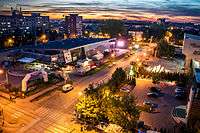
Timișoara was the first city in the country with international routes economic boom as the amount of foreign investment, especially in high-tech sectors, has risen. In an article in late 2005, French magazine L'Expansion called Timișoara Romania's economic showcase, and referred to the increased number of foreign investments as a "second revolution". In 2016, Timișoara was awarded by Forbes as the most dynamic city and the best city for business in Romania.[25]
Apart from domestic local investment, there has been significant foreign investment from the European Union, particularly from Germany and Italy. Continental AG has produced tires since opening a plant in 1998.[26] In the years that followed, Continental also established an automotive software engineering division in Timișoara. All in all, as of 2015 Continental AG employed about 8000 people in Timișoara, and the company keeps expanding.[27] The Linde Group produces technical gases, and a part of the wiring moulds for BMW and Audi vehicles are produced by the company Dräxlmaier Group. Wiring for Volkswagen and other vehicles are produced at the German company Kromberg & Schubert. Also, Swiss company FM Logistic, already present in Timiș County for Alcatel-Lucent, Nestlé, P&G, Smithfield and in Bucharest for Cora, L'Oréal, Sanofi Aventis and Yves Rocher, and for companies like PROFI Rom Foods, BIC, Kraft Foods or SCA Packaging—offering them domestic transport services and international transport services for Bricostore, Arctic, Danone, Unilever or Contitech, the growth of FM Logistic in Romania and in Dudești through its first warehouse in Romania (Dudeștii Noi gives FM the opportunity). Nestlé produces waffles here. Among the chain restaurants present are Mcdonald's, KFC, Pizza Hut, Subway and Starbucks.
The city has two shopping malls: Iulius Mall Timișoara[28] and Shopping City Timișoara.[29] A third one will be completed in 2018, Timișoara Centrum.[30] A fourth is planned to be build, Timișoara Plaza.[31]
The USA company Flextronics maintains a workplace in the west of the city for the production of mobile telephony and government inspection department devices. In 2009, the company laid off 640 workers.[32] The American company Procter & Gamble manufactures washing and cleaning agents in Timișoara. Smithfield Foods—the world's largest pork processor and hog producer—has two subsidiaries in Timișoara and Timiș County: Smithfield Ferme and Smithfield Prod.
Transport

Timișoara has a complex system of regional transportation, providing road, air and rail connections to major cities in Romania and Europe. It also features a public transportation system consisting of bus, trolleybus and tram lines.
Timișoara is on two European routes (E70 and E671) in the European road network. At a national level, Timișoara is located on four different national roads: DN6, DN69, DN59 and DN59A. The Romanian Motorway A1, under construction on some sections, will link the city with Bucharest and the eastern part of the country. The A1 is currently the only Romanian motorway that crosses a border, linking Timișoara with Hungarian motorway M43. The Timișoara Coach Station (Autogara) is used by several private transport companies to provide coach connections from Timișoara to a large number of locations from all over the country.[33]
The city is served by Romania's third busiest airport, Traian Vuia International Airport, located 10 km (6.2 mi) northeast away from the city centre. It used to be the hub of Romanian airline Carpatair, and it serves now as an operating base for low-cost airlines Ryanair and Wizz Air. There are regular flights from/to numerous major European and domestic destinations, such as Barcelona, Berlin, Brussels Charleroi, London Stansted, Munich, Rome or Paris.
Timișoara's public transport network consists of 10 tram lines, trolleybus lines and 23 bus lines, of which 4 are metropolitan lines and 8 are express lines. It is operated by Regia Autonomă de Transport Timișoara (RATT), an autonomous institution of the City Hall. Timișoara is a major railway centre and is connected to all other major Romanian cities, as well as local destinations, through the national CFR network. Timișoara is directly linked by train service with Budapest, Belgrade , Vienna and Sofia.
In 2015 Timișoara became the first city in Romania to offer public transport by bike. The bicycle-sharing system has 25 stations and 300 bikes which can be used by locals and tourists for free.[34] Starting from 2016, RATT also offers vaporetto public transport on the Bega canal, resulting in Timișoara being the only city in Romania with 5 types of public transportation.[35]
Cityscape
Currently, the tallest building is the Timișoara Orthodox Cathedral, at 91 metres (299 feet) and the tallest office building is the Fructus Tower, at 65 metres (213 feet). Other tall buildings, over 60 metres (200 feet), include: Asirom Financial Centre, Bosch Center, Continental Hotel and United Business Center 2. Another proposed building, the United Business Center 0, should be completed by the end of 2017 and will be part of the mixed use urban regeneration project: Openville. When completed, the building will have a height of 155 metres (509 feet).
Government


The first free elections in post-communist Timișoara took place in 1992. The winner was Viorel Oancea, of the Civic Alliance Party (PAC), which later merged with the Liberal Party. He was the first officer who spoke to the crowd of revolutionaries gathered in Opera Square. The 1996 elections were won by Gheorghe Ciuhandu, of the Christian Democrats. He had four terms, also winning elections in 2000, 2004 and 2008. Meanwhile, Ciuhandu took over the Christian Democratic Party and ran for president of Romania in 2004. Timișoara's mayor, elected in 2012 and again in 2016, is Nicolae Robu. Deputy mayors are Dan Diaconu (PNL) and Farkas Imre (UDMR).
Like all other local councils in Romania, the Timișoara local council, the county council and the city's mayor are elected every four years by the population. Decisions are approved and discussed by the local council (consiliu local) made up of 27 elected councillors.[36] Local council composition after 2016 local elections:[37]
| Party | Seats | Current Council | ||||||||||||
|---|---|---|---|---|---|---|---|---|---|---|---|---|---|---|
| National Liberal Party (PNL) | 12 | |||||||||||||
| Social Democratic Party (PSD) | 9 | |||||||||||||
| People's Movement Party (PMP) | 2 | |||||||||||||
| Democratic Alliance of Hungarians in Romania (UDMR/RMDSZ) | 2 | |||||||||||||
| Alliance of Liberals and Democrats (ALDE) | 1 | |||||||||||||
| Adrian Orza (independent) | 1 | |||||||||||||
Additionally, as Timișoara is the capital of Timiș County, the city hosts the palace of the prefecture, the headquarters of the county council (consiliu județean) and the prefect, who is appointed by Romania's central government. The prefect is not allowed to be a member of a political party, and his role is to represent the national government at the local level, acting as a liaison and facilitating the implementation of National Development Plans and governing programmes at the local level. County council composition after 2016 local elections:[38]
| Party | Seats | Current Council | ||||||||||||||||
|---|---|---|---|---|---|---|---|---|---|---|---|---|---|---|---|---|---|---|
| Social Democratic Party (PSD) | 16 | |||||||||||||||||
| National Liberal Party (PNL) | 14 | |||||||||||||||||
| People's Movement Party (PMP) | 5 | |||||||||||||||||
| Alliance of Liberals and Democrats (ALDE) | 2 | |||||||||||||||||
Currently, the city is the largest in the West development region, which is equivalent to NUTS-II regions in the European Union and is used by the European Union and the Romanian Government for statistical analysis and regional development. The West development region is not, however, an administrative entity.[36]
Districts

Timișoara city traditionally divided into ten parts, but now they have no administrative function.
| District | Area (ha) | Romanian name | German name | Hungarian name | Institution |
|---|---|---|---|---|---|
| I | 480 | Cetate | Innere Stadt | Belváros | 1718 |
| II | 1017 | Fabric | Fabrikstadt | Gyárváros | 1718 |
| III | 668 | Elisabetin | Elisabethstadt | Erzsébetváros | 1890 |
| IV | 442 | Iosefin | Josefstadt | Józsefváros | 1744 |
| V | 205 | Mehala | Mehala | Mehala | 1910 |
| VI | 231 | Fratelia | Fratelia | Újkissoda | 1948 |
| VII | 156 | Freidorf | Freidorf | Szabadfalu | 1950 |
| VIII | 67 | Plopi | Kardos-Kolonie | Kardostelep | 1951 |
| IX | 72 | Ghiroda Nouă | Neu-Giroda | Erzsébetpuszta | 1951 |
| X | 102 | Ciarda Roșie | Rote Tscharda | Vörös Csárda | 1953 |
In the 21st century, Timișoara city is divided into quarters (cartiere):
- Listed alphabetically
|
|
|
Culture and contemporary life

The city center largely consists of buildings from the Austrian Empire era. The old city consists of several historic areas. These are: Cetate (Belváros in Hungarian, Innere Stadt in German), Iosefin (Józsefváros, Josephstadt), Elisabetin (Erzsébetváros, Elisabethstadt), Fabric (Gyárváros, Fabrikstadt). Numerous bars, clubs and restaurants have opened in the old Baroque square (Unirii Square).
- Timișoara Orthodox Cathedral
- St. George's Cathedral (The Dome)
- Millennium Church
- Iosefin Synagogue
- Fabric Synagogue
- Cetate Synagogue
- Serbian Orthodox Cathedral
- Maria Theresia Bastion[39]
- Victory Square (Piața Victoriei)
- Liberty Square (Piața Libertǎții)
- Union Square (Piața Unirii)
- St.Maria Square (Piața Maria)
- Saint George Square (Piața Sfântul Gheorghe)
- Traian Square (Piața Traian)
- Plevnei Square (Piața Plevnei)
- Huniade Castle
- House of Florymund Mercy
- Brück House
- House with Lions
- House with Atlantes
- Emmer House
- Mühle House
- The Turkish House
- Dauerbach Palace
- Deschan Palace
- The Dicasterial Palace
- Hilt Palace
- Vogel Palace
- Lloyd Palace
- Löffler Palace
- Merbl Palace
- Neuhausz Palace
- Széchényi Palace
- Weiss Palace
- Water Palace
- Baroque Palace
- The Roman Catholic Palace
- Romanian Post Palace
- The old town Hall
- Military Casino
- The military hospital
- Historic abattoir
- Neptune Public Bathroom
- The Piarist Complex
- The Bega canal
- December 1989 Revolution Museum
Cultural Buildings
- National Opera
- Mihai Eminescu National Theatre
- Csiky Gergely Hungarian State Theatre
- German State Theatre
- Merlin Pupper Theatre [4]
- Banat Phiharmonic
Statues and historical monuments
- Statue of the Holy Trinity
- Statue of St. Maria
- Statue of St. Nepomuk
- Capitoline Wolf Statue
- St. George's Monument
- Traian Square Obelisk
- Heroes Monument[3]
Museums
- Art Museum Timișoara
- Banat Village Museum
- Military Museum
- December 1989 Revolution Museum
- Museum of Banat
- Museum of the Orthodox Metropolitan Cathedral
- Art Collection of the Serbian Episcopacy
- Zoo
Performing arts
- Banatul Philharmonic of Timișoara (Filarmonica Banatul Timișoara)
- Romanian Opera House (Opera Română Timișoara)[40]
- National Theatre (Teatrul Național) http://ro.tntimisoara.com
- German State Theatre (Teatrul German de Stat)
- Hungarian State Theatre (Teatrul Maghiar de Stat)
- Puppet Theatre (Teatrul pentru copii și tineret "Merlin")
Parks, Forests and gardens
- Botanical Park
- Central Park
- Cathedral Park
- Alpineț Park
- Justice Park
- Lidia Park
- Roses Park
- Ion Creangă Children's Park
- Civil Park
- Queen Maria Park
- Elisabeth of Wied Park
- Zoological Garden
- Green Forest [17]
Festivals and Conferences
- Plai Festival
- Revolution Festival – music festival held in June at the Village Museum
- Timișoara Jazz Festival (JazzTM) – international jazz festival that takes place outdoors, in Victory Square (and starting from 2016 also in the Civic and Justice parks), in July and brings to the scene international jazz artists
- Teszt Festival – euroregional theatre festival
- Timishort – Timishort is a short movie festival held since 2009
- Ceau, Cinema! – Ceau, Cinema! is a "pocket-size" independent film festival that takes place in July made by volunteers and film enthusiasts with the support of local companies and cultural partners. It also takes place in Gottlob, which has the first reconditioned cinema in rural Romania.[41]
- StudentFest – a festival of culture and arts created by the students which has been held ever since 1992.[42]
- International Festival of Literature from Timișoara – the festival, held in October since 2012, brings together Romanian and foreign authors, for two days of lectures and open dialogue with the public
- Street Delivery Festival – Organized in Bucharest, Timișoara and Iași, the festival reaches areas such as architecture, music, theater, dance and film
- Timișoara Tango Festival – Argentine Tango event
- ISWinT – The International Students Week in Timișoara
- TEDxTimișoara – an independent conference organized under license from TED Conference[43][44][45][46]
- SABOTAGE Festival – Indoor Electronic Music and Art Festival held in October
- launmomentdat în parc Festival – Electronic Music and Art Festival held in the Botanical Park during June
European Capital of Culture
In 16 September 2016 Timișoara was selected as Romanian host city of European Capital of Culture in 2021.[47] The city will co-host the event with Novi Sad and Eleusis.
Shopping and commerce
Due to high demand for business space new commercial buildings have been built. The commercial sector is developing very quickly. Timișoara have two large shopping centers:
- €105 million Iulius Mall Timișoara,[48] one of the biggest shopping centers in Romania, with an over 66.500 m2 lettable area, 350 stores and parking for 3000 cars.
- €85 million Shopping City Timișoara[29] with 57.000 m2 lettable area, 110 brands, 13 cinema halls with IMAX and 4DX and 2700 parking places.
A third mall will be completed in 2018, Timișoara Centrum.[49] A fourth is planned to be build, Timișoara Plaza.[50]
Timișoara also have several hypermarkets : Metro, Kaufland, Auchan, Carrefour, Billa and Selgros ; DIY stores Leroy Merlin, Praktiker, Dedeman, Hornbach (hypermarket), Arabesque (company) ; and supermarkets Carrefour Market, Lidl, Penny Market, Profi , Unicarm and sport retailer Decathlon Group. The city is undergoing a retail boom, with supermarkets and hypermarkets opened every year.
Education
Timișoara is the main educational and academic centre in west of Romania. Timișoara has four public universities and four private universities. The number of students of higher education institutions reached 60,000 in 2015.
Public
- West University[51]
- "Politechnica" University of Timișoara[52]
- "Victor Babeș" University of Medicine and Pharmacy[53]
- Banat's University of Agricultural Sciences[54]
Private
- Dimitrie Cantemir University[55]
- Tibiscus University[56]
- Mihai Eminescu University[57]
- Ioan Slavici University[58]
Sport
Association football
Historic
Basketball
- BC Timișoara (M)
- BC Timba Timișoara (M)
- CSȘ Bega Timișoara (W)
Handball
Rugby union
International relations
Twin towns – Sister cities
Timișoara has 17 twin towns and sister cities, as listed below:[59]
Consulates
|
Gallery
-

Canal in the 2012 summer
-

Victory Square at night
-
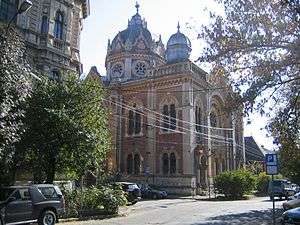
The Fabric Synagogue
-

Bus in Timișoara
-
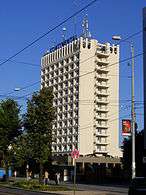
Tallest hotel (Continental)
-

Mid-day
-

Evening rush hour
-

Polytechnic University's sports ground
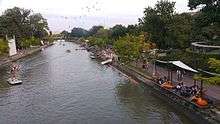
Panorama
_-_Apr_2016.jpg)
See also
References
- ↑ Timișoara – City of Roses by Rudolf Strutz – issuu
- 1 2 3 "Timiș County at the 2011 census" (PDF) (in Romanian). INSSE. February 2, 2012. Retrieved February 16, 2012.
- ↑ Timișoara 2021 – European Capital of Culture
- ↑ Primaria Timișoara | City Presentation | Historical background
- ↑ Gate Azapa Citeste mai mult: adevarul.ro/locale/timisoara/aniversare-trista-timisoara-1552-s-a-lasat-intunericul-dominatiei-otomane-banat-1_50aef2737c42d5a663a1d771/index.html
- ↑ http://www.collectionscanada.gc.ca/obj/s4/f2/dsk2/ftp01/MQ37222.pdf
- ↑ History of Timisoara | Primaria Timisoara | City Presentation | Timisoara Municipality
- ↑ Ilieșiu 2006, op. cit. p. 330
- ↑ TIMISOARA, Romania – Travel and Tourism Information
- ↑ Info Centrul Turistic Timisoara | Timisoara's Firsts
- ↑ Metal Bridge, Timișoara·
- ↑ "20 decembrie 1989: Timişoara, primul oraş liber de comunism". www.digi24.ro. Retrieved 2016-01-08.
- ↑ Climate Summary for Timișoara, Romania
- ↑ "Timișoara Climate Normals 1961–1990". National Oceanic and Atmospheric Administration. Retrieved 21 March 2015.
- ↑ "Klimatafel von Temeschburg (Temesvar, Timisoara), Banat / Rumänien" (PDF). Baseline climate means (1961–1990) from stations all over the world (in German). Deutscher Wetterdienst. Retrieved 23 November 2016.
- ↑ "Air Temperature (monthly and yearly absolute maximum and absolute minimum)" (PDF). Romanian Statistical Yearbook: Geography, Meteorology, and Environment. Romanian National Statistic Institute. 2007. Archived from the original (PDF) on September 27, 2007. Retrieved 21 March 2015.
- ↑ "Ethno-demographic Structure of Romania". The Ethnocultural Diversity Resource Center. Retrieved April 15, 2011.
- ↑ "Timișoara, mina de aur pentru investitorii italieni". 9am.ro. Retrieved 2010-06-18.
- ↑ QCT Connect (1992-08-19). ""Timișoara este floarea de la butonieră a relațiilor româno-italiene" | Primaria Timișoara | Secțiuni suplimentare | Cooperare internațională și dezvoltare economică". Primariatimisoara.ro. Retrieved 2010-06-18.
- ↑ "Centrul de resurse pentru diversitate etnoculturală". Edrc.ro. 2010-05-30. Retrieved 2010-06-18.
- ↑ http://www.historia.ro/exclusiv_web/general/articol/premierele-timisoarei-primul-oras-strazi-iluminate-electric-cea-mai-vec
- ↑ "Timișoara, monografie Istorică", dr.Nicolae Ilieșu
- ↑ "Agenda". Agenda.ro. Retrieved 2010-06-18.
- ↑ "Agenda". Agenda.ro. Retrieved 2010-06-18.
- ↑ Timișoara, the best city for business in Romania, in Forbes top 2016 | swisspointgroup
- ↑ Continental Corporation -Istoric Continental
- ↑ Grupul Continental vrea să recruteze 3.000 de noi ingineri în următorii doi ani | Ziarul Financiar
- ↑ https://www.iuliusmall.com/en/timisoara
- 1 2 Shopping City Timișoara
- ↑ "New shopping center to be opened in Romania's Timișoara in 2017". Romania-Insider.
- ↑ Plaza Centers partners with Auchan for mall in Romania’s Timișoara | Europaproperty.com
- ↑ Flextronics Romania to cut an additional 140
- ↑ Timisoara – Gara (Timisoara, Timis, Romania) – Transport persoane cu autocare, autobuze sau microbuze la AUTOGARI.RO
- ↑ "Velo TM – Timișoara Has The First Romanian Bike-Sharing System". Alexandru Garboni Blog.
- ↑ "Romania's Timișoara will provide free public transport by boat on the canal crossing the city". Romania-Insider.
- 1 2 LEGE nr.215 din 23 aprilie 2001 Legea administraţiei publice locale
- ↑ "Noul Consiliu Local Timișoara". Opinia Timișoarei.
- ↑ "Avem rezultate finale oficiale! Vezi clasamentul partidelor și harta votului în Timiș, la Alegerile Locale 2016!". Opinia Timișoarei.
- ↑ Info Centrul Turistic Timișoara | The Theresia Bastion
- ↑ "Romanian Opera House". ort.ro. Retrieved 2010-06-18.
- ↑ "Ceau, Cinema! Patru zile pentru cinefili, în iulie".
- ↑ "Article about StudentFest in TION".
- ↑ "TEDxTimișoara".
- ↑ "TEDxTimișoara events on TED.com".
- ↑ "Article about TEDxTimișoara in Ziua de Vest".
- ↑ Nani, Corina. "Festivalul International Graffiti Timișoara 2011". Street Art Album. ArtPress Timișoara.
- ↑ Timișoara to be the European Capital of Culture in Romania in 2021 – European Commission
- ↑ http://www.iuliusmall.com/en/timisoara
- ↑ New shopping center to be opened in Romania’s Timișoara in 2017 – Romania Insider
- ↑ Plaza Centers partners with Auchan for mall in Romania's Timișoara – Romania Insider
- ↑ "The West University of Timișoara". Uvt.ro. Retrieved 2010-06-18.
- ↑ "The Politehnica University of Timișoara". Upt.ro. Retrieved 2010-06-18.
- ↑ "Victor Babeș University of Medicine and Pharmacy, Timișoara". Umft.ro. 2009-08-29. Retrieved 2010-06-18.
- ↑ "The Banat's University of Agricultural Sciences in Timișoara". Usab-tm.ro. Retrieved 2010-06-18.
- ↑ "The Dimitrie Cantemir University of Timișoara". Ucdctm.ro. Retrieved 2010-06-18.
- ↑ "The Tibiscus University of Timișoara". Tibiscus.ro. Retrieved 2010-06-18.
- ↑ "Mihai Eminescu University of Timișoara". Umet.ro. Retrieved 2011-03-10.
- ↑ "Ioan Slavici University of Timișoara". Islavici.ro. Retrieved 2012-01-14.
- ↑ Primaria Timișoara | Prezentarea oraşului | Oraşe înfrăţite
- ↑ 友好城市 (Friendly cities), 市外办 (Foreign Affairs Office), 2008-03-22. (Translation by Google Translate.)
- ↑ 国际友好城市一览表 (International Friendship Cities List), 2011-01-20. (Translation by Google Translate.)
- ↑ 友好交流 (Friendly exchanges), 2011-09-13. (Translation by Google Translate.)
- ↑ "Städtepartnerschaften" (in German). Stadt Karlsruhe. 2010-12-16. Archived from the original on 2010-07-24. Retrieved 2011-01-05.
- ↑ "European networks and city partnerships". Nottingham City Council. 11 March. Retrieved 2013-07-20. Check date values in:
|date=(help) - ↑ http://fad.danang.gov.vn/default.aspx?id_NgonNgu=EN&id_ThucDon_Sub=177&TinChinh=0&id_TinTuc=5560&TrangThai=BanTin. Missing or empty
|title=(help) - ↑ Misiuni în România | Ministry of Foreign Affairs
- ↑ Misiuni în România | Ministry of Foreign Affairs
- ↑ Misiuni în România | Ministry of Foreign Affairs
- ↑ Misiuni în România | Ministry of Foreign Affairs
- ↑
- ↑
- ↑
- ↑
- ↑ Misiuni în România | Ministry of Foreign Affairs
- ↑ Misiuni în România | Ministry of Foreign Affairs
- ↑ Misiuni în România | Ministry of Foreign Affairs
- ↑ Misiuni în România | Ministry of Foreign Affairs
- ↑ Misiuni în România | Ministry of Foreign Affairs
- ↑ Misiuni în România | Ministry of Foreign Affairs
External links
| Wikimedia Commons has media related to Timișoara. |
| Wikimedia Commons has media related to Timișoara. |
| Wikivoyage has a travel guide for Timișoara. |
- People from Timișoara
- An introduction to Timișoara by Prof. Harry W. Morgan
- Timișoara's home page, the oldest Romanian page on the net
- City of Timișoara Homepage
- Tourist Bureau of Romania
- Updated map of Timișoara
